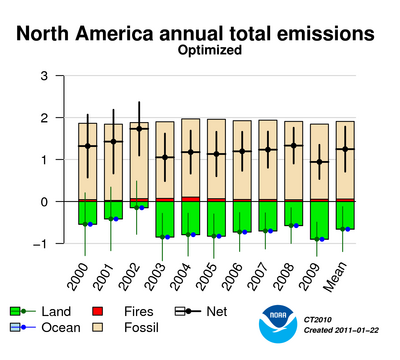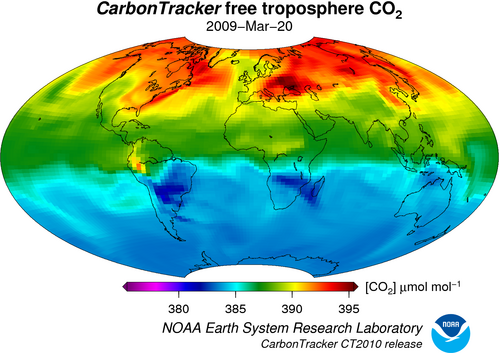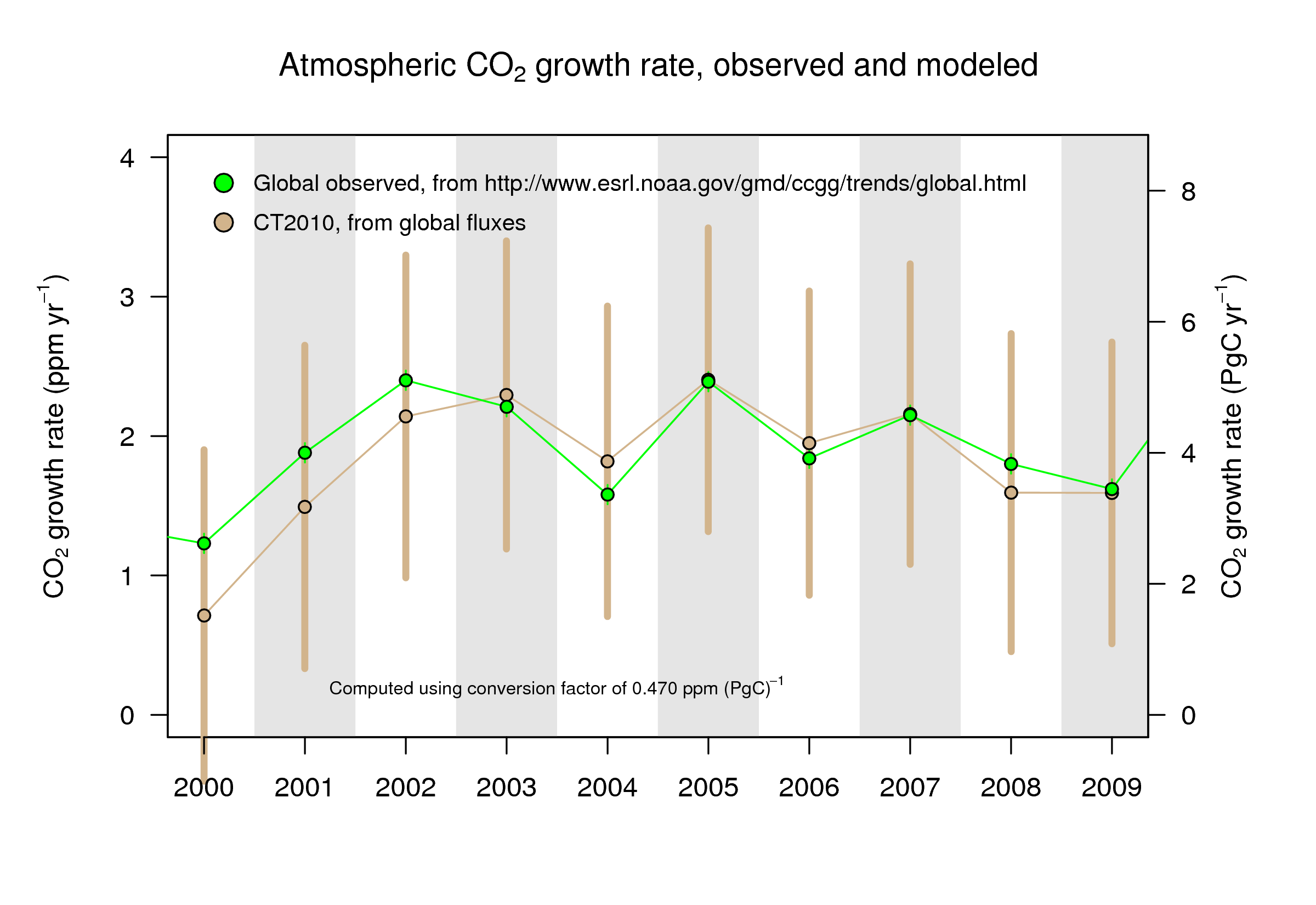|
Information
Results
Get Involved
Resources
|
|
Executive Summary - CT2010
|
|
|
CarbonTracker 2010
CarbonTracker 2010 is the fifth release of NOAA's combined CO2 measurement and modeling system. CarbonTracker is designed to keep track of sources (emissions to the atmosphere) and sinks (removal from the atmosphere) of carbon dioxide around the world, using atmospheric CO2 observations from a host of collaborators. The current release of CarbonTracker, CT2010, provides global estimates of these surface fluxes of CO2 from January 2000 through December 2009.
Notice: methodological changes CarbonTracker 2010 is a unique release due to a reanalysis over only part of the record and the use of components from differing land models to form the terrestrial first-guess fluxes. Details are below.
Estimates of CO2 sources and sinks over North America
From 2001 through 2009, ecosystems in North America have
been a net sink of 0.66 ± 0.54 PgC yr-1 (1 Petagram Carbon equals 1015 gC, or 1 billion metric ton C, or
3.67 billion metric ton CO2).
This natural sink offsets about one-third of the
emissions of about 1.9 PgC yr-1 from
the burning of fossil fuels in the U.S.A., Canada and
Mexico combined (Figure 1).

| Figure 1. Annual total emissions from North America. The bars
in this figure represent CO2
emissions for each year in PgC yr-1 from the U.S.A., Canada, and Mexico combined. See map on this page.
CarbonTracker models four types of surface-to-amosphere
exchange of CO2, each of which
is shown in a different color: fossil fuel emissions
(tan), terrestrial biosphere
flux excluding fires (green), direct emissions from
fires (red), and air-sea gas
exchange (blue).
Negative
emissions indicate that the flux removes CO2 from the atmosphere. The net
surface exchange, computed as the sum of these four
components, is shown as a thick black line.
|
Whereas fossil emissions are generally steady over
this period, ranging between 1.8 and 1.9 PgC yr-1, the amount of CO2
taken up by the North American biosphere varies significantly from
year to year. In terrestrial biosphere models, inter-annual
variability in land uptake can be related to anomalies in large-scale
temperature and precipitation patterns. While the CarbonTracker
period of analysis is relatively short compared to the dynamics of
slowly-changing pools of biospheric carbon, episodes of extremes in
net ecosystem exchange (NEE) have been associated with climatic anomalies (see e.g. Peters et al., 2007). It is interesting to note
that the inferred year-to-year variabilty (the "range") of land uptake
is actually as big as the mean sink itself.
The year with the smallest annual uptake by terrestrial ecosystems in North America
was 2002, when there was widespread drought in the U.S. west. During
this year, land ecosystems accounted for a sink of only 0.2 PgC yr-1. This reduced land sink is largely responsible
for 2002 being the year in the CarbonTracker record with the largest
input of CO2 to the atmosphere from North
America, when net emissions reached 1.7 ± 0.6 PgC yr-1.
In contrast, our observing system did not detect an effect from the
2007 drought in the U.S. Southeast. This is likely due to
lack of coverage of the area (Figure 3) in our current
observing network. New observations in CT2010 compared
to CT2009, however, do lead to interesting differences in
this region for 2008. For CT2010 in 2008, the U.S. Southeast
represents a distinct source of carbon dioxide to the
atmosphere, whereas CT2009
fluxes for this same place and time are equivocal.
In CT2010, we find that 2009 was the year with the largest North American land
sink, with ecosystems taking up about 0.9 PgC yr-1—a land sink that is about 36% bigger than the average. Fossil
fuel emissions from North America were also slightly reduced in 2009
compared to earlier years as a result of the economic
downturn. As a result, ecosystems removed about half of fossil fuel emissions over North America in 2009, and this was the year with the lowest net input of
CO2 to the atmosphere from North America.
This 2009 net annual emission was 0.9 ± 0.4 PgC yr-1, about 25% smaller than the average of 1.3
± 0.5 PgC yr-1. This is the
first year since the beginning of the CarbonTracker record in 2000 for
which the net flux from North America has fallen below
1 PgC yr-1.
Spatial distribution of surface fluxes
CarbonTracker flux estimates include sub-continental patterns of
sources and sinks coupled to the distribution of dominant ecosystem
types across the continent (Figure 2). We have greater confidence in
countrywide totals than in estimates of regional sources and sinks,
but we expect that such finer-scale estimates will become more robust
with future expansion of the CO2 observing
nework. Our results indicate that the sinks are
mainly located in the agricultural regions of the Midwest
(36%), deciduous forests along the East Coast (33%), and
boreal coniferous forests (17%).
 | | Figure 2. Mean ecosystem fluxes. The
pattern of net ecosystem exchange (NEE) of CO2 of the land biosphere averaged over
2001-2009, as estimated by CarbonTracker. This NEE
represents land-to-atmosphere carbon exchange from
photosynthesis and respiration in terrestrial ecosystems,
and a contribution from fires. It does not include fossil
fuel emissions. Negative fluxes (blue colors) represent
CO2 uptake by the land
biosphere, whereas positive fluxes (red colors) indicate
regions in which the land biosphere is a net source of
CO2 to the atmosphere. Units
are gC m-2 yr-1.
|
Word of caution about high-resolution biological flux maps
Figure 2 shows estimated fluxes by ecoregion.
While we also provide flux maps and data with a finer
1° x 1° spatial resolution, for example
on our flux maps pages, these
ecoregions define the actual scales at which
CarbonTracker operates. With the present observing
network, the detailed one-degree fluxes should not be
interpreted as quantitatively meaningful for each block.
Any within-ecoregion patterns come directly from results of the terrestrial
biosphere model.
Part of this high-resolution patterning comes from variations of
temperature, precipitation, light, plant species, and
soil type over each ecoregion. To spread the influence
of measurements from the sparse observation network,
CarbonTracker makes adjustments uniformly over an entire
ecoregion.
These adjustments scale the net ecosystem flux of CO2 predicted by the terrestrial
biosphere model by the same factor across each ecoregion.
Thus we caution that the 1° x 1°
spatial detail in CarbonTracker land fluxes is based on
the simulations of the terrestrial biosphere model and
the assumption of large-scale ecosystem coherence. This
has not been verified by observations.
The CarbonTracker observing system
CarbonTracker
surface flux estimates are optimally consistent with
measurements of ~31,500 flask samples of air from 81
sites across the world, ~27,800 four-hourly averages of
continuously measured CO2 at 13
sites (10 in North America, plus observatories at Mauna
Loa, Hawaii; Barrow, Alaska, South Pole; and American Samoa), and
~23,800 four-hourly averages from towers at 13 locations
within the continent (see Figure 3). Eight of these
towers sample air from heights more than 100m above
ground level.
|
|
Figure 3. CarbonTracker 2010 Observational Network Click on any site marker for more information. Double-click on a site marker to center the map on that site.
|
Calculated time-dependent CO2 fields throughout the global atmosphere
A "byproduct" of the data assimilation system, once
sources and sinks have been estimated, is that the mole fraction of
CO2 is calculated everywhere in
the model domain and over the entire 2000-2009 time
period, based on the optimized source and sink estimates (Figure 4).
As a check on model transport properties and CarbonTracker inversion performance, calculated
CO2 mole fractions are regularly
compared with measurements of ~31,000 air samples taken by
NOAA/ESRL at 26 aircraft sites, which are not used in the
estimation of optimized sources and sinks.
Since CarbonTracker simulates CO2 throughout the entire atmospheric
column, the model atmosphere can be sampled exactly like
satellite retrievals of CO2.
Such estimates are generally more sensitive to the CO2 mole fraction in some parts of the
atmosphere than in others, and by using a vertical profile
of this sensitivity, a direct analog of the satellite
estimate can be constructed.

|
|
Figure 4. Carbon dioxide weather
Shown is the daily average of the pressure-weighted mean mole fraction of carbon dioxide
in the free troposphere as modeled by CarbonTracker for March 20, 2009. Units are
micromoles of CO2 per mole of dry air
(μmol mol-1), and the values are given by
the color scale depicted under the graphic. The "free troposphere" in
this case is levels 6 through 10 of the TM5 model. This corresponds to about 1.2km above
the ground to about 5.5km above ground, or in pressure terms, about
850 hPa to about 500 hPa. Gradients in CO2
concentration in this layer are due to exchange between the atmosphere
and the earth surface, including fossil fuel emissions, air-sea
exchange, and the photosynthesis, respiration, and wildfire emissions
of the terrestrial biosphere. These gradients are subsequently
transported by weather systems, even as they are gradually erased by
atmospheric mixing.
|
Flux uncertainties
It is important to note that at this time the uncertainty
estimates for CarbonTracker sources and sinks are
themselves quite uncertain. They have been derived from
the mathematics of the ensemble data assimilation system,
which requires several educated
guesses for initial uncertainty estimates. The
paper describing CarbonTracker (Peters et al. (2007),
Proc. Nat. Acad. Sci. vol. 104, p. 18925-18930)
presents different uncertainty estimates based on the
sensitivity of the results to 14 alternative yet
plausible ways to construct the CarbonTracker system.
For example, the 14 realizations produce a range of the
net annual mean terrestrial emissions in North America of
-0.40 to -1.01 PgC -1
(negative emissions indicate a sink). The procedure is
described in the Supporting Information Appendix to that
paper, which is freely downloadable from the PNAS web
site. Furthermore, the estimates do not take into
account several additional factors noted below. The
calculation is set up for sources and sinks to slowly
revert, in the absence of observational data, to first
guesses of net ecosystem exchange, which are close to
zero on an annual basis. This set-up may result in a
bias. Also due to the sparseness of measurements, we
have had to assume coherence of ecosystem processes over
large distances, giving existing observations perhaps an
undue amount of weight. The process model for
terrestrial photosynthesis and respiration was very
basic, and will likely be greatly improved in future
releases of CarbonTracker. Easily the largest single
annual mean source of CO2 is
emissions from fossil fuel burning, which are currently
not estimated by CarbonTracker. We use estimates from
emissions inventories (economic accounting) and subtract
the CO2 mole fraction signatures
of those fluxes from observations. As a result, the
biosphere and ocean fluxes estimated by CarbonTracker
inherit error from the assumed fossil fuel emissions.
While these emissions inventories may have a small
relative error on global scales (perhaps 5 or
10%), any such bias translates into a larger
relative error in the annual mean ecosystem sources and
sinks, since those fluxes have smaller magnitudes. We
expect to add a process model of fossil fuel combustion
in future releases of CarbonTracker. Finally, additional
measurement sites are expected to lead to the greatest
improvements, especially to more robust and specific
source/sink results at smaller spatial scales.
Consistency of modeled and observed atmospheric CO2 growth rates
Global atmospheric CO2 growth
rates inferred directly from observed carbon dioxide at marine surface sites are
consistent with those modeled by CarbonTracker, both in their average
values and in their year-to-year variations (Figure 5). These global
growth rates continue to hover at around 4 PgC yr-1, or around 1.9 ppm yr-1 (Figure 5). The 2009 growth rate modeled by
CarbonTracker was below average at 3.4 ±
3.1 PgC yr-1. This was not due to
a significant decrease in fossil fuel emissions, as can be seen from
estimates of
global fluxes used in CarbonTracker. Instead, the most notable difference for the 2009
atmospheric growth rate appears to be reduced biomass burning fluxes
from the tropics
and southern hemisphere, which at 1.4 PgC yr-1 are about 0.5 PgC yr-1 below their 2001-2009 mean of
1.9 PgC yr-1.

| | Figure 5. Atmospheric CO2 growth rates. Observed atmospheric CO2 growth rates (source: NOAA ESRL page on global trends in CO2) are plotted against the atmospheric CO2 growth rate inferred from CT2010 global fluxes. Note that error bars on the observed growth rates are relatively small and may not be visible on this plot. |
|
CT2010 methodological differences
There are two main methodological differences between CT2010 and
CT2009: - The CarbonTracker 2010
release is a reanalysis covering the period 2007-2009. The CT2010
results prior to 2007 are those of the previous CT2009 release. We
did this because the newest
fossil fuel emissions estimates affect the years 2007 through
2009 only. These revisions do not impact fossil emissions estimates
over 2000-2006. Furthermore, the stations which are newly
assimilated in CT2010 mostly do not have CO2 measurements before 2007. As a result, all
CT2010 results for the period 2000-2006 are identical to those from
CT2009.
- The biological model we use to provide first-guess
fluxes for terrestrial net ecosystem exchange (NEE) has
been revised. This year the CASA-GFED team has
transitioned to a model (version 3.1) driven by MODIS
fPAR. The previous revision (version 2) of this model
used AVHRR
NDVI, scaled to represent MODIS fPAR. We have found
that the seasonal cycle of globally-integrated NEE is
reduced by about 10% in CASA-GFED3.1 compared to
CASA-GFED2. CarbonTracker will require re-tuning of its
optimization system to operate with this new model. This
is a research problem we will be addressing over the next
release cycle. Despite our inability to exploit
CASA-GFED3.1 NEE fluxes in the current configuration of
CarbonTracker, that model remains vitally important
because it is the only means we have to assess fire
emissions for 2009. We have chosen a hybrid approach for
CT2010, combining elements of the old and new models.
While the fire emissions come from CASA-GFED3.1,
terrestrial NEE first guess fluxes derive from CASA-GFED2.
The NEE fluxes have real estimated interannual variations
for 2007 and 2008, but since CASA-GFED2 analysis stops in
2008, first-guess fluxes in 2009 are computed from the
climatological NEE of CASA-GFED2. This is not
unprecedented. For several previous releases, we have
used climatological first-guess fluxes for the final year
in the analysis cycle.
Details of these methodological differences are presented
in the "What's New?" page and
the CT2010 documentation.
|
|
CarbonTracker is a NOAA contribution to the North American Carbon Program
|
|